-
REFLECTION01-01-2015
Research lines in nursing: phylosophical and epistemological highlights
Revista Brasileira de Enfermagem. 2015;68(4):723-729
Abstract
REFLECTIONResearch lines in nursing: phylosophical and epistemological highlights
Revista Brasileira de Enfermagem. 2015;68(4):723-729
DOI 10.1590/0034-7167.2015680421p
Views0See moreRESUMEN
Objetivo:
elucidar destaques filosóficos y epistemológicos mediante consideraciones en favor de la casualidad de cuestiones en el interés de la Enfermería.
Método:
es fundamentado en las proposiciones teóricas de Johannes Hessen y de otros autores consagrados.
Resultados:
clareamiento de aspectos sustantivo e implicaciones adjetivas no sólo el interés de la investigación, resaltando los significados esenciales del asunto coincidido con las elaboraciones de disertaciones y tesis (Maestría y Doctorado de Enfermería).
Conclusión:
texto representa una contribución valiosa para esclarecer mejor detalles de la construcción del conocimiento en la temática y problemática del asunto puesto en causa.
-
REVIEW01-01-2015
Using the theory of meaningful learning in nursing education
Revista Brasileira de Enfermagem. 2015;68(4):713-722
Abstract
REVIEWUsing the theory of meaningful learning in nursing education
Revista Brasileira de Enfermagem. 2015;68(4):713-722
DOI 10.1590/0034-7167.2015680420i
Views0See moreABSTRACT
Objective:
to synthesize the scientific literature about the Theory of Meaningful Learning in the process of teaching and learning in nursing.
Method:
this is an integrative review conducted in the databases MEDLINE, LILACS, SciELO, BDENF and CINAHL with studies addressing the subject or aspects of the theory of meaningful learning of David Ausubel. Ten studies were included, from which six were written in Portuguese and four in English, published from 1998 to 2013.
Results:
five studies used the theory of meaningful learning, four studies cited Ausubel as the author of this theory and only two studies followed the framework for the application of the theory completely. There are only a few studies on this subject and those which explore it are not correlated with Ausubel’s theory.
Conclusion:
it is necessary to break with the dichotomy between theory and practice and promote the articulation of content with action, introducing the student as the author of their own knowledge.
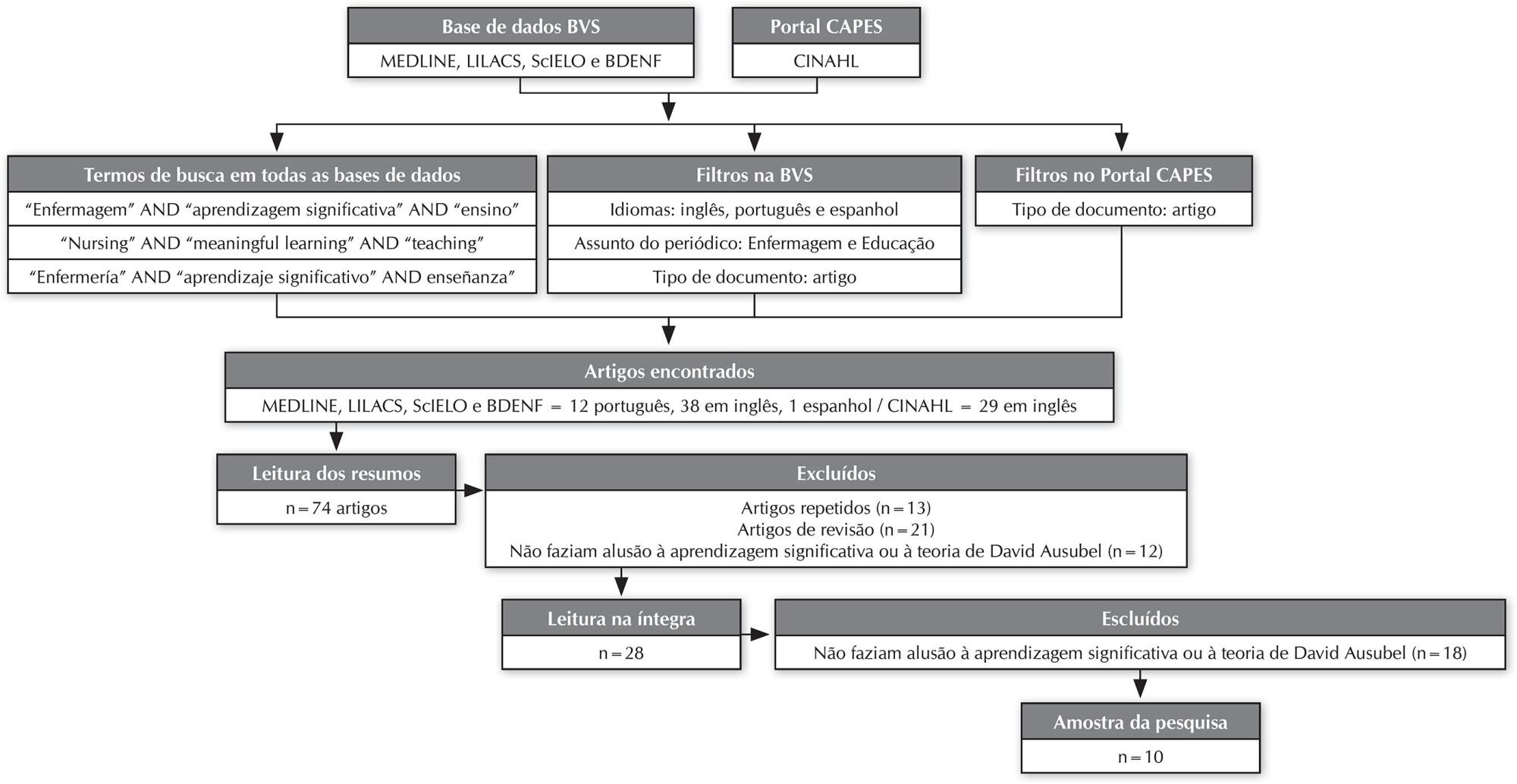
-
REVIEW01-01-2015
Nursing scientific production on health promotion, chronic condition, and aging
Revista Brasileira de Enfermagem. 2015;68(4):705-712
Abstract
REVIEWNursing scientific production on health promotion, chronic condition, and aging
Revista Brasileira de Enfermagem. 2015;68(4):705-712
DOI 10.1590/0034-7167.2015680419i
Views0See moreABSTRACT
Objective:
to characterize the scientific production of Postgraduate Programs Nursing in Brazil on health promotion with a focus on elderly people with chronic conditions in the period from 2006 to 2010.
Method:
integrative research developed by searching for dissertations and theses in the database of the Center for Nursing Studies and Research of the Brazilian Nursing Association published in the period from 2006 to 2010 and which focused on health promotion for elderly people with chronic conditions.
Results:
five themes emerged: “Living with the disease”; “Technologies of care”, “Potential for self-care” “Psycho-spiritual dimension”, and “Family caregiver”.
Conclusion:
it was possible to identify nursing care as a key element to promote the health of elderly people and make them more independent in their care so as to live with their limitations or disabilities, even when affected by chronic diseases.
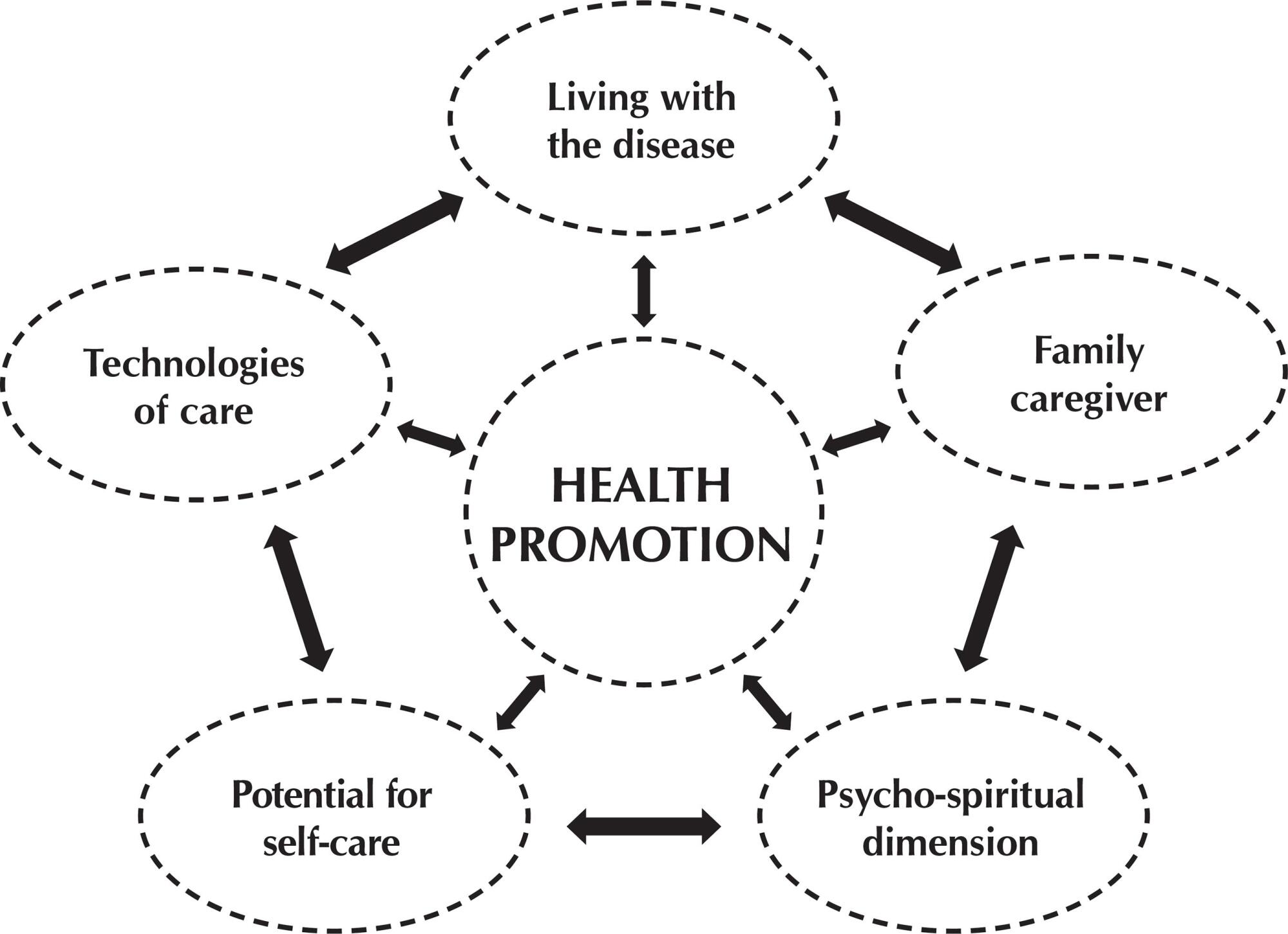
-
RESEARCH01-01-2015
Longevity according to life histories of the oldest-old
Revista Brasileira de Enfermagem. 2015;68(4):697-704
Abstract
RESEARCHLongevity according to life histories of the oldest-old
Revista Brasileira de Enfermagem. 2015;68(4):697-704
DOI 10.1590/0034-7167.2015680418i
Views0See moreABSTRACT
Objective:
to interpret life histories of the oldest-old in a community, grounded on the perspective of the Active Aging and Life Course.
Method:
this is a qualitative research. Participants included twenty seniors 80 years and older, users of a Basic Health Unit. Life histories were collected and analyzed according to the proposition of the Autobiographical Narrative Interview.
Results:
during the analytic process, elements found in the elders’ present and past arose, contributing to the development of a theoretical model: “Building longevity along the life course.”
Conclusion:
longevity is rooted in the past, strongly infl uenced by the family culture and life course; assumptions of the Active Aging are more meaningful in the informants’ present trajectory. The content of the narratives pointed to new possibilities of Gerontology Nursing intervention in Primary Care, aiming at health promotion and intervention, specially grounded on the respect to the oldest-elders’ culture.

-
RESEARCH01-01-2015
Accuracy in inference of nursing diagnoses in heart failure patients
Revista Brasileira de Enfermagem. 2015;68(4):690-696
Abstract
RESEARCHAccuracy in inference of nursing diagnoses in heart failure patients
Revista Brasileira de Enfermagem. 2015;68(4):690-696
DOI 10.1590/0034-7167.2015680417i
Views0See moreABSTRACT
Objective:
to determine the accuracy of nursing diagnoses of fatigue, intolerance to activity and decreased cardiac output in hospitalized HF patients.
Method:
descriptive study applied to nurses with experience in NANDA-I and/or HF nursing diagnoses. Evaluation and accuracy were determined by calculating effi cacy (E), false negative (FN), false positive (FP) and trend (T) measures. Nurses who showed acceptable inspection for two diagnoses were selected.
Results:
the nursing diagnosis of fatigue was the most commonly mistaken diagnosis identifi ed by the nursing evaluators.
Discussion:
the search for improving diagnostic accuracy reaffi rms the need for continuous and specifi c training to improve the diagnosis capability of nurses.
Conclusion:
the training allowed the exercise of clinical judgment and better accuracy of nurses.
-
RESEARCH01-01-2015
Direct cost of development and documentation of the nursing process
Revista Brasileira de Enfermagem. 2015;68(4):683-689
Abstract
RESEARCHDirect cost of development and documentation of the nursing process
Revista Brasileira de Enfermagem. 2015;68(4):683-689
DOI 10.1590/0034-7167.2015680416i
Views0See moreABSTRACT
Objective:
identify the average direct cost (ADC) of the activities performed by nursing professionals in the nursing process development and documentation at the medical clinic of a teaching hospital.
Method:
1040 activities were observed and the ADC was calculated by multiplying the time spent by professionals by the unit cost of direct labor.
Results:
the ADC of patient admission was R$ 55.57 (SD=19.44); among the activities of patient follow-up, the assessment phase documentation had the most significant ADC (R$ 17.70 – SD=14.60); the ADC of descriptive records corresponded to R$ 1.21 (SD=1.21) and the ADC of the nursing team for shift change was R$ 54.23 (SD=28.95).
Conclusion:
the study promotes visibility of the work performed by nursing professionals in the development of the nursing process, providing financial data to ensure consistent arguments for proper resources to its feasibility.
-
RESEARCH01-01-2015
Health status and mental health in patients after percutaneous coronary intervention
Revista Brasileira de Enfermagem. 2015;68(4):676-682
Abstract
RESEARCHHealth status and mental health in patients after percutaneous coronary intervention
Revista Brasileira de Enfermagem. 2015;68(4):676-682
DOI 10.1590/0034-7167.2015680415i
Views0See moreABSTRACT
Objective:
to assess the association between perceived health status and the mental health of patients submitted to percutaneous coronary intervention after hospital discharge.
Method:
a quantitative and cross-sectional study involving 101 participants. The following instruments were used: a sociodemographic and clinical characterization instrument, the Medical Outcomes Study 36-Item Short-Form Health Survey (SF-36), and the Hospital Anxiety and Depression Scale (HADS). Participants were divided into three groups: no anxiety and no depression (G1); anxiety or depression (G2); and both (G3). The ANOVA test was used for the intergroup comparison of means on the SF-36 domains.
Results:
There was an association between perceived health status and mental health. The participants in G1 presented higher scores in all SF-36 domains in comparison with participants in G2 and G3.
Conclusion:
Participants with no anxiety and depression presented better-perceived health status in comparison with those with anxiety or depression, or both.
-
RESEARCH01-01-2015
Analysis of the decision-making process of nurse managers: a collective refl ection
Revista Brasileira de Enfermagem. 2015;68(4):668-675
Abstract
RESEARCHAnalysis of the decision-making process of nurse managers: a collective refl ection
Revista Brasileira de Enfermagem. 2015;68(4):668-675
DOI 10.1590/0034-7167.2015680414i
Views0ABSTRACT
Objective:
to analyze the decision-making model adopted by nurses from the perspective of some decision-making process theories.
Method:
qualitative approach, based on action research. Semi-structured questionnaires and seminars were conducted from April to June 2012 in order to understand the nature of decisions and the decision-making process of nine nurses in position of managers at a public hospital in Southern Brazil. Data were subjected to content analysis.
Results:
data were classified in two categories: the current situation of decision-making, which showed a lack of systematization; the construction and collective decision-making, which emphasizes the need to develop a decision-making model.
Conclusion:
the decision-making model used by nurses is limited because it does not consider two important factors: the limits of human rationality, and the external and internal organizational environments that infl uence and determine right decisions.
Keywords:Decision Support PracticesNursingNursing Administration ResearchPractice ManagementProfessional CompetenceSee more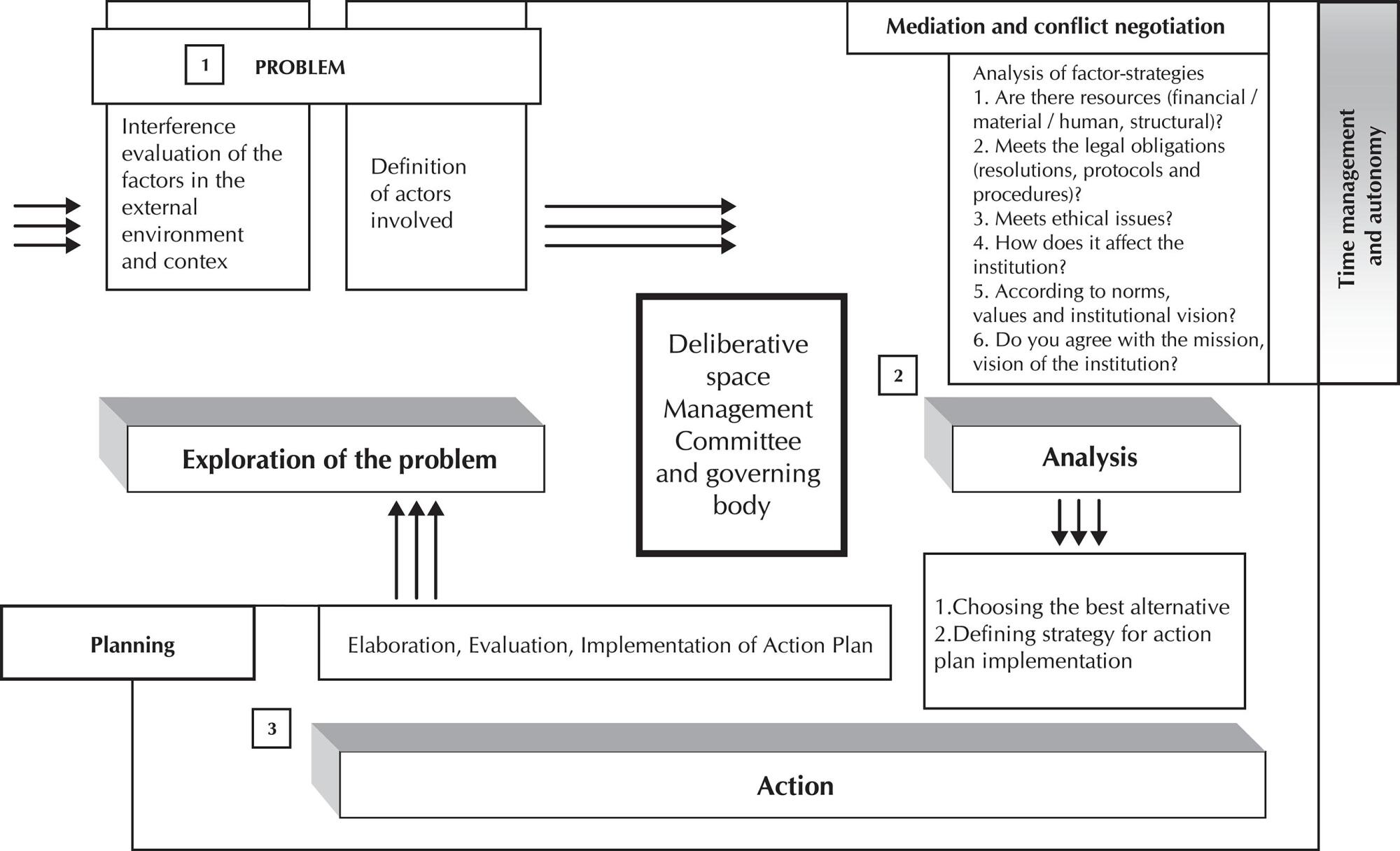
-
EXPERIENCE REPORT08-19-2019
Hypothermia post-cardiopulmonary resuscitation with low inputs: an experience report
Revista Brasileira de Enfermagem. 2019;72(4):1114-1118
Abstract
EXPERIENCE REPORTHypothermia post-cardiopulmonary resuscitation with low inputs: an experience report
Revista Brasileira de Enfermagem. 2019;72(4):1114-1118
DOI 10.1590/0034-7167-2017-0771
Views1ABSTRACT
Objective:
to report the experience of conducting directed temperature control of a post-cardiopulmonary resuscitation patient, with reduced and basic inputs available at the institution.
Method:
an experience report of directed temperature control in patient (age 15 years), after four hours of cardiopulmonary resuscitation in an Intensive Care Unit of a hospital in São Paulo State countryside in 2016, according to the protocol suggested by the American Heart Association, in 2015. There were applications of cold compresses, plastic bags with crushed ice and rectal temperature control.
Results:
after eight hours, temperature had reached 93.2 ºF. Body cooling was maintained for 24 hours. However, bags with crushed ice were used in the first 6 hours.
Conclusion:
conduct of nurses to obtain the body cooling with reduced and basic inputs was effective during the stay at the Intensive Care Unit.
Keywords:Body Temperature RegulationCardiopulmonary ResuscitationHeart ArrestHypothermia InducedIntensive Care UnitsSee more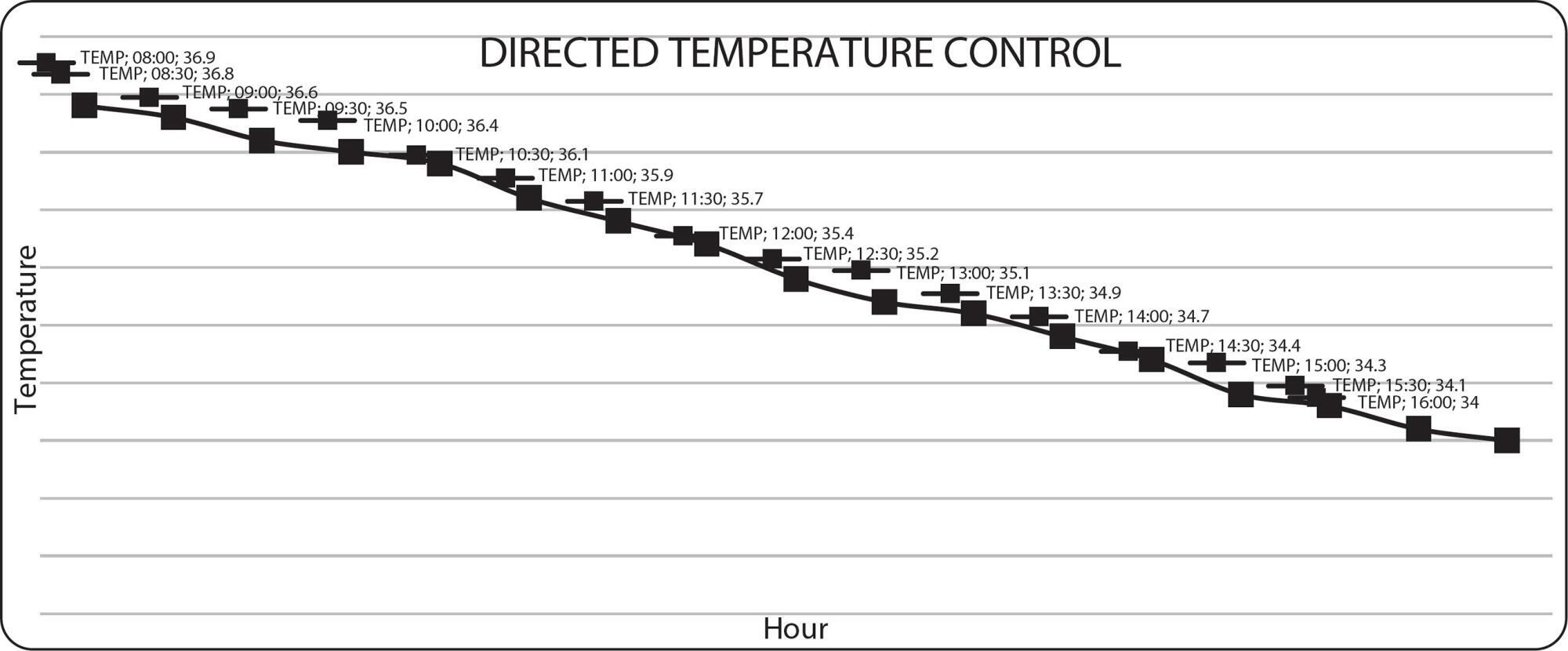
-
Individual and contextual variables associated with smoking and alcohol consumption during pregnancy
Revista Brasileira de Enfermagem. 2021;74:e20200804
Abstract
Individual and contextual variables associated with smoking and alcohol consumption during pregnancy
Revista Brasileira de Enfermagem. 2021;74:e20200804
DOI 10.1590/0034-7167-2020-0804
Views1See moreABSTRACT
Objective:
to analyze the association between individual characteristics and housing context with smoking and alcohol consumption during pregnancy.
Methods:
a cross-sectional study with a probabilistic sample of 3,580 pregnant women who underwent prenatal care in the Unified Health System in 2019. The outcomes were firsthand, secondhand smoke and alcohol consumption during pregnancy. Individual characteristics and the living environment were used as exploratory variables.
Results:
living in a neighborhood with episodes of violence, without social cohesion and without urban elements that encourage physical activity was associated with smoking. Alcohol consumption during pregnancy was associated with living in environments that do not encourage physical activity. Smoking was also associated with lower income and education.
Conclusions:
individual characteristics and the living environment are associated with smoking, secondhand smoke and alcohol consumption during pregnancy.
-
Overview of clinical trial protocols for behavioral insomnia in infants
Revista Brasileira de Enfermagem. 2021;74:e20200769
Abstract
Overview of clinical trial protocols for behavioral insomnia in infants
Revista Brasileira de Enfermagem. 2021;74:e20200769
DOI 10.1590/0034-7167-2020-0769
Views1See moreABSTRACT
Objective:
to describe the overview of clinical trial protocols for behavioral insomnia in infants.
Methods:
an analytical study that reviewed protocols registered with the International Clinical Trials Registry Platform between August and September 2019, aiming to identify the interventions for behavioral insomnia in infants, the comparators, the main primary, secondary outcomes and their respective measurements.
Results:
eleven protocols registered between 2004 and 2018 were included. Nurses were the main coordinators of protocols (45.5%), with proposals using educational technologies, one-to-one and online follow-up consultations. The main outcome was improvement of infant and maternal sleep patterns. Secondary outcomes were anxiety, depression, and parental sexual satisfaction. To measure them, the following were used: sleep diary (54.5%), actigraphy (45.4%), and the Pittsburgh Sleep Quality Interview (36.3%) and Extended Brief Infant Sleep Questionnaire (27.2%) were used.
Conclusion:
the protocols proposed interventions for independent sleep, aiming at quality of sleep for the whole family.
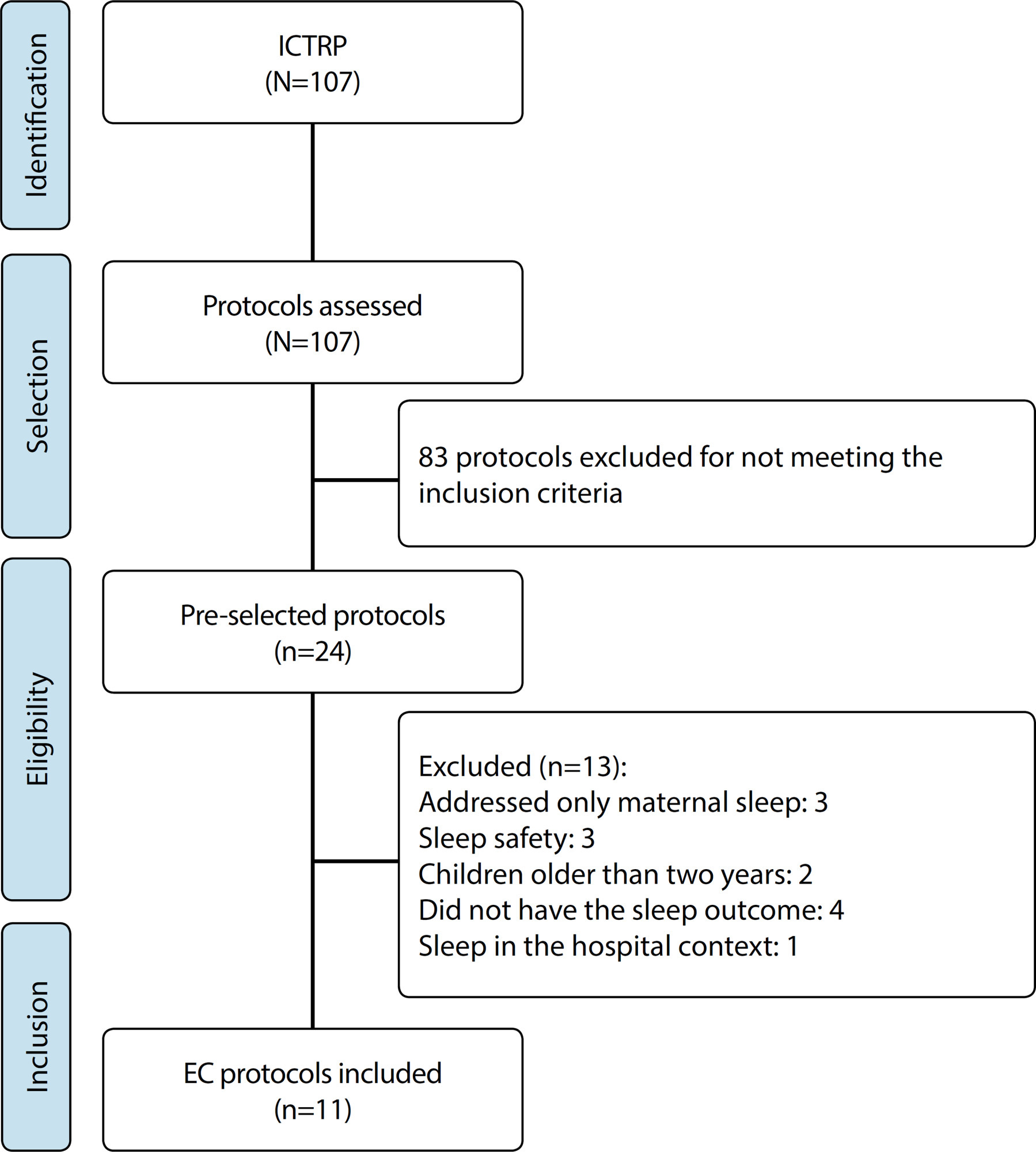
-
ORIGINAL ARTICLE07-30-2021
Curricular reforms in the transformation of nursing teaching in a federal university
Revista Brasileira de Enfermagem. 2021;74(4):e20201242
Abstract
ORIGINAL ARTICLECurricular reforms in the transformation of nursing teaching in a federal university
Revista Brasileira de Enfermagem. 2021;74(4):e20201242
DOI 10.1590/0034-7167-2020-1242
Views1See moreABSTRACT
Objectives:
to discuss the curricular reforms adopted for nursing teaching in Brazil, from 1969 to 2019.
Methods:
historical, qualitative approach using the thematic oral history and document research. 13 interviews were carried out with graduation nursing professors from a federal university in the South of Brazil. The document sources were the political-pedagogical projects of the course and their associated documents. Minayo’s thematic analysis was used.
Results:
nursing curricula delineates the profile of the professional that must be formed and are reviewed in order to be adapted to social and educational changes, showing the scientific and professional potential of the nurse. Curricular reforms consider the quality of nursing formation.
Final Considerations:
the structure of the curriculum and the reforms that took place emerged according to the historical, political, epidemiological and social context demanded from the profession, to attend to the demands of society and to the work market.
-
REVIEW07-09-2021
Breast cancer screening in Primary Health Care in Brazil: a systematic review
Revista Brasileira de Enfermagem. 2021;74(3):e20200995
Abstract
REVIEWBreast cancer screening in Primary Health Care in Brazil: a systematic review
Revista Brasileira de Enfermagem. 2021;74(3):e20200995
DOI 10.1590/0034-7167-2020-0995
Views1See moreABSTRACT
Objectives:
to analyze care strategies for breast cancer screening in Primary Health Care in Brazil.
Methods:
this is a systematic review following the Cochrane Collaboration recommendations.
Results:
among 355 manuscripts, five were eligible. The patient navigation program by Community Health Agent stood out with the best result, among the strategies: flexibility of goals considering viability; community engagement; team training; active search of the target population by Community Health Agent; request for mammography by physicians; actions integrated to women’s health; monitoring of mammography results, absent users, and population coverage by physician and nurse; and assessment of criteria for requesting screening mammography by means of an information system. The population coverage rate in the program ranged from 23% to 88%.
Conclusions:
Primary Health Care in Brazil presents devices with potential to induce the production of care for breast cancer screening.
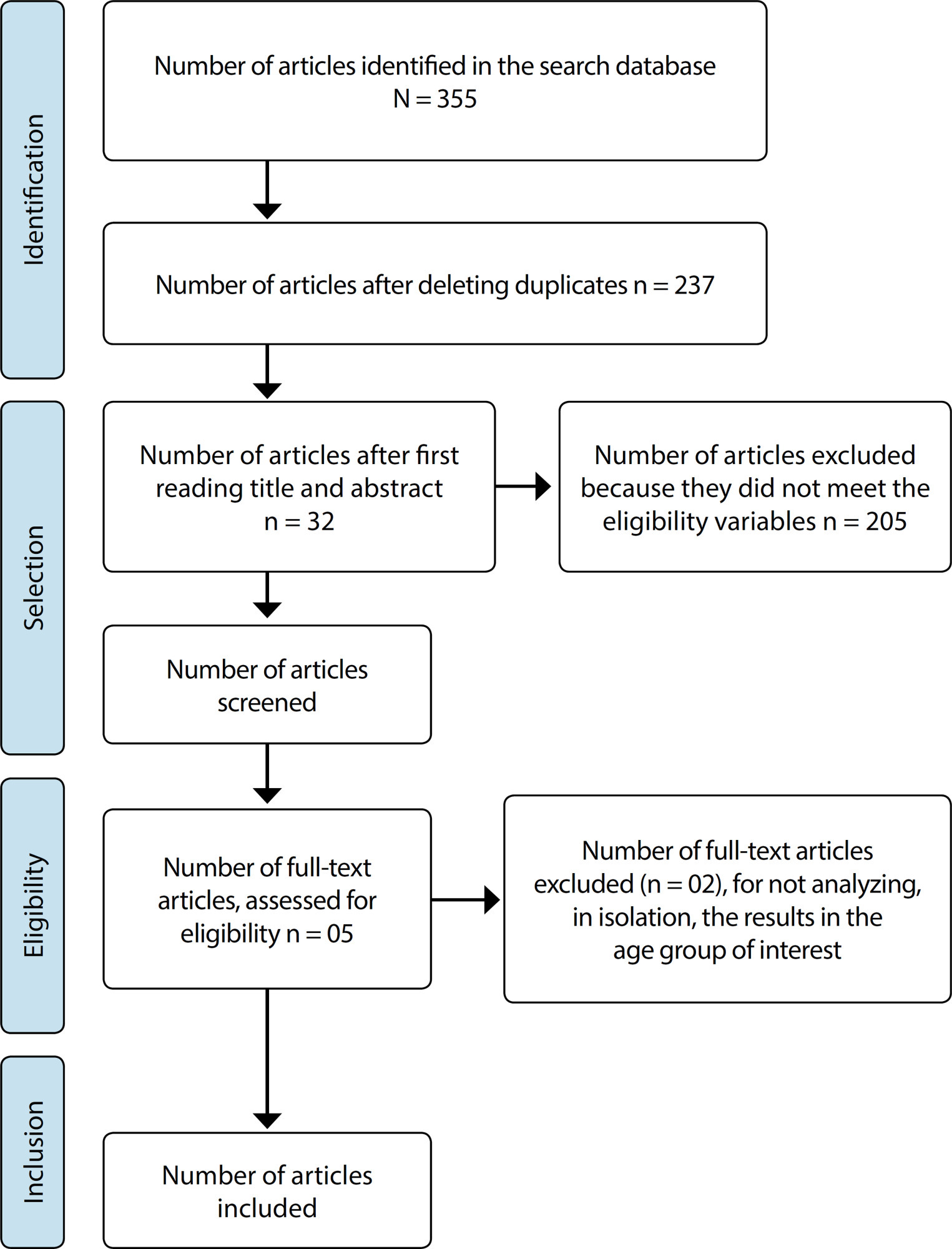
-
ORIGINAL ARTICLE05-28-2021
Cultural adaptation and validation of an instrument about nursing critical thinking skills
Revista Brasileira de Enfermagem. 2021;74(2):e20200720
Abstract
ORIGINAL ARTICLECultural adaptation and validation of an instrument about nursing critical thinking skills
Revista Brasileira de Enfermagem. 2021;74(2):e20200720
DOI 10.1590/0034-7167-2020-0720
Views1See moreABSTRACT
Objectives:
to validate the Nursing Critical Thinking in Clinical Practice Questionnaire regarding cultural aspects and metric properties.
Methods:
a methodological research carried out through cross-cultural adaptation, face and content validity, dimensional construct and known groups validity, test-retest reliability and internal consistency. 511 nurses from four hospitals participated in the study, of which 54 participated in retest.
Results:
the instrument validation for Brazilian Portuguese maintained equivalences, according to the original version. The dimensional validity demonstrated adjustment to the tetrafactorial structure of the original version (GFI=0.69). There were statistically significant differences in critical thinking skills between nurses with graduate degrees and who undertook training, reading articles, developing research and working in an institution with a longer time implementation of the Nursing Process. The instrument showed temporal stability (ICC 073-0.84; p<0.001) and adequate internal consistency (α=0.97).
Conclusions:
the instrument proved to be valid and reliable for the studied population.
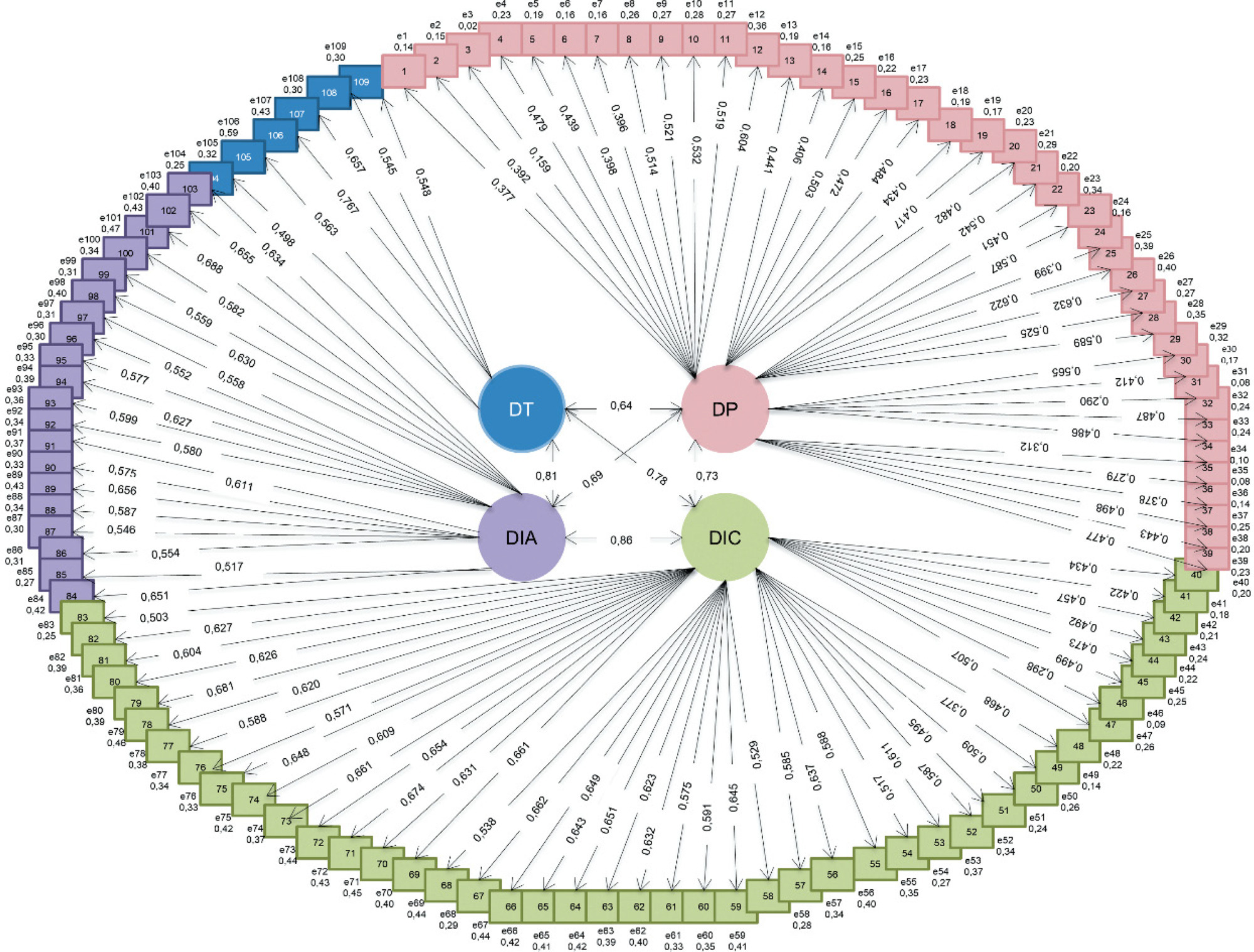
-
ORIGINAL ARTICLE05-28-2021
Prevalence and severity levels of post-radical prostatectomy incontinence: different assessment instruments
Revista Brasileira de Enfermagem. 2021;74(2):e20200692
Abstract
ORIGINAL ARTICLEPrevalence and severity levels of post-radical prostatectomy incontinence: different assessment instruments
Revista Brasileira de Enfermagem. 2021;74(2):e20200692
DOI 10.1590/0034-7167-2020-0692
Views1See moreABSTRACT
Objectives:
to analyze urinary incontinence prevalence and severity in prostatectomized men assessed by three different instruments.
Methods:
a cross-sectional study was conducted with 152 men. The pad test, pad used, and International Consultation on Incontinence Questionnaire – Short Form (self-report) were considered. Data were analyzed using Spearman’s correlation, Kappa index, considering a significance level of 0.05.
Results:
urinary incontinence prevalence was 41.4%, 46.7% and 80.3% according to pad used, pad test and self-report. Positive correlations and moderate to poor agreement were found between the instruments. As for severity, most participants had mild incontinence. The largest number of cases of mild and severe incontinence was identified by self-report.
Conclusions:
the self-report showed higher values for prevalence of mild and severe severity levels. Through the identified differences, we propose that the objective assessment (pad used and pad test) be associated with individuals’ perception (self-report) to better estimate prevalence and severity.

-
ORIGINAL ARTICLE05-28-2021
Managed clinical protocol: impact of implementation on sepsis treatment quality indicators
Revista Brasileira de Enfermagem. 2021;74(2):e20200282
Abstract
ORIGINAL ARTICLEManaged clinical protocol: impact of implementation on sepsis treatment quality indicators
Revista Brasileira de Enfermagem. 2021;74(2):e20200282
DOI 10.1590/0034-7167-2020-0282
Views1See moreABSTRACT
Objectives:
to assess the impact of the implementation of a managed sepsis protocol on quality indicators of treatment for septic patients in an emergency department of a university hospital.
Methods:
an observational epidemiological study involving septic patients. The study was divided into two phases, pre-intervention and intervention, resulting from the implementation of the managed sepsis protocol. The study variables included sepsis treatment quality indicators. The results were statistically analyzed using the program Epi InfoTM.
Results:
the study sample included 631 patients, 95 from pre-intervention phase and 536 from intervention phases. Implementing the protocol increased patients’ chances of receiving the recommended treatment by 14 times. Implementing the protocol reduced the hospitalization period by 6 days (p <0.001) and decreased mortality (p <0.001).
Conclusions:
this study showed that implementing the managed protocol had an impact on the improvement of sepsis treatment quality indicators.
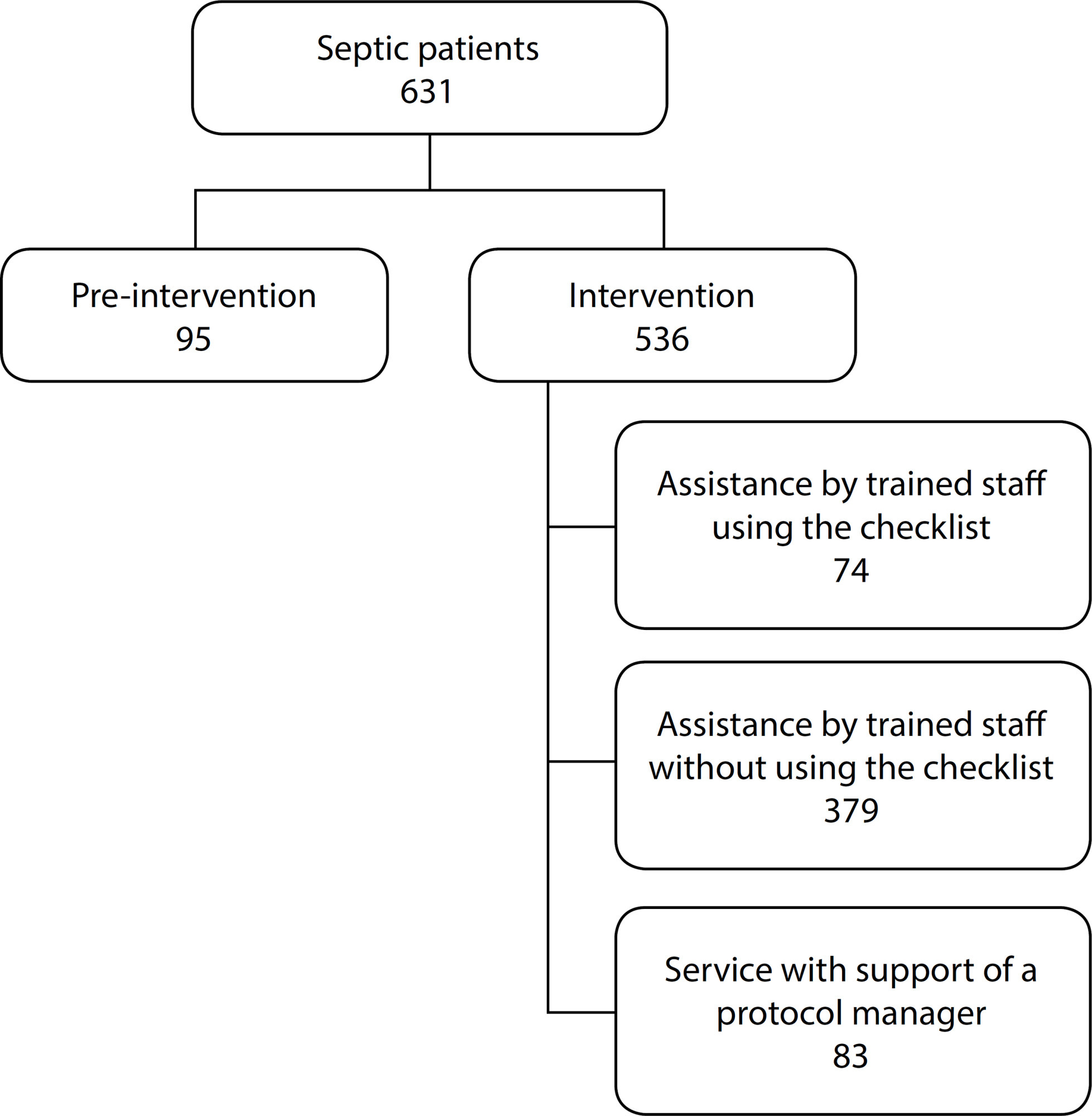
-
ORIGINAL ARTICLE08-30-2021
Mental health in adolescence: Elaboration and validation of an educational technology for health promotion
Revista Brasileira de Enfermagem. 2021;74(5):e20201023
Abstract
ORIGINAL ARTICLEMental health in adolescence: Elaboration and validation of an educational technology for health promotion
Revista Brasileira de Enfermagem. 2021;74(5):e20201023
DOI 10.1590/0034-7167-2020-1023
Views0See moreABSTRACT
Objective:
to build and validate the appearance of a digital educational technology to promote the mental health of school adolescents.
Methods:
methodological study, which included the elaboration and validation of the “Conect@dos com a S@ude” online course based on the Galvis-Panqueva methodological framework. The elaboration was based on a literature review and followed the Theory of Meaningful Learning. The validation was performed by a total of 21 adolescent students, using an instrument adapted for the study. A quantitative analysis was performed from the Content Validity Index and descriptive of the suggestions pointed out by the target audience.
Results:
the analysis of the Content Validity index ranged from 0.8 to 1 in all evaluated items. The adolescents presented some suggestions for improvement for the course, most of them were accepted.
Conclusion:
the course was validated by the target audience.

-
REVIEW08-16-2021
Fatigue due to compassion in health professionals and coping strategies: a scoping review
Revista Brasileira de Enfermagem. 2021;74(5):e20190628
Abstract
REVIEWFatigue due to compassion in health professionals and coping strategies: a scoping review
Revista Brasileira de Enfermagem. 2021;74(5):e20190628
DOI 10.1590/0034-7167-2019-0628
Views0See moreABSTRACT
Objectives:
to identify the current state of knowledge on compassion fatigue in the work context of healthcare professionals; and how coping strategies are established in this scenario.
Method:
a scoping review with search applied to the databases: MEDLINE, LILACS, CINAHL, Scopus. Temporal limit: 2009 to 2019. The data was analyzed and synthesized in narrative form
Results:
thirty articles were selected, synthesized into two categories: a) Health work and compassion fatigue: conceptual analysis, context, and manifestations; b) Coping strategies for compassion fatigue.
Conclusions:
this study presented: a descriptive and general panorama about compassion fatigue in healthcare professionals, identifying a greater consolidation of the concept between 2015 and 2018; and some coping strategies. The association between health and spirituality is highlighted as one of the strategies in this scenario, enabling new research to be conducted in view of the importance of the theme in life, health work.
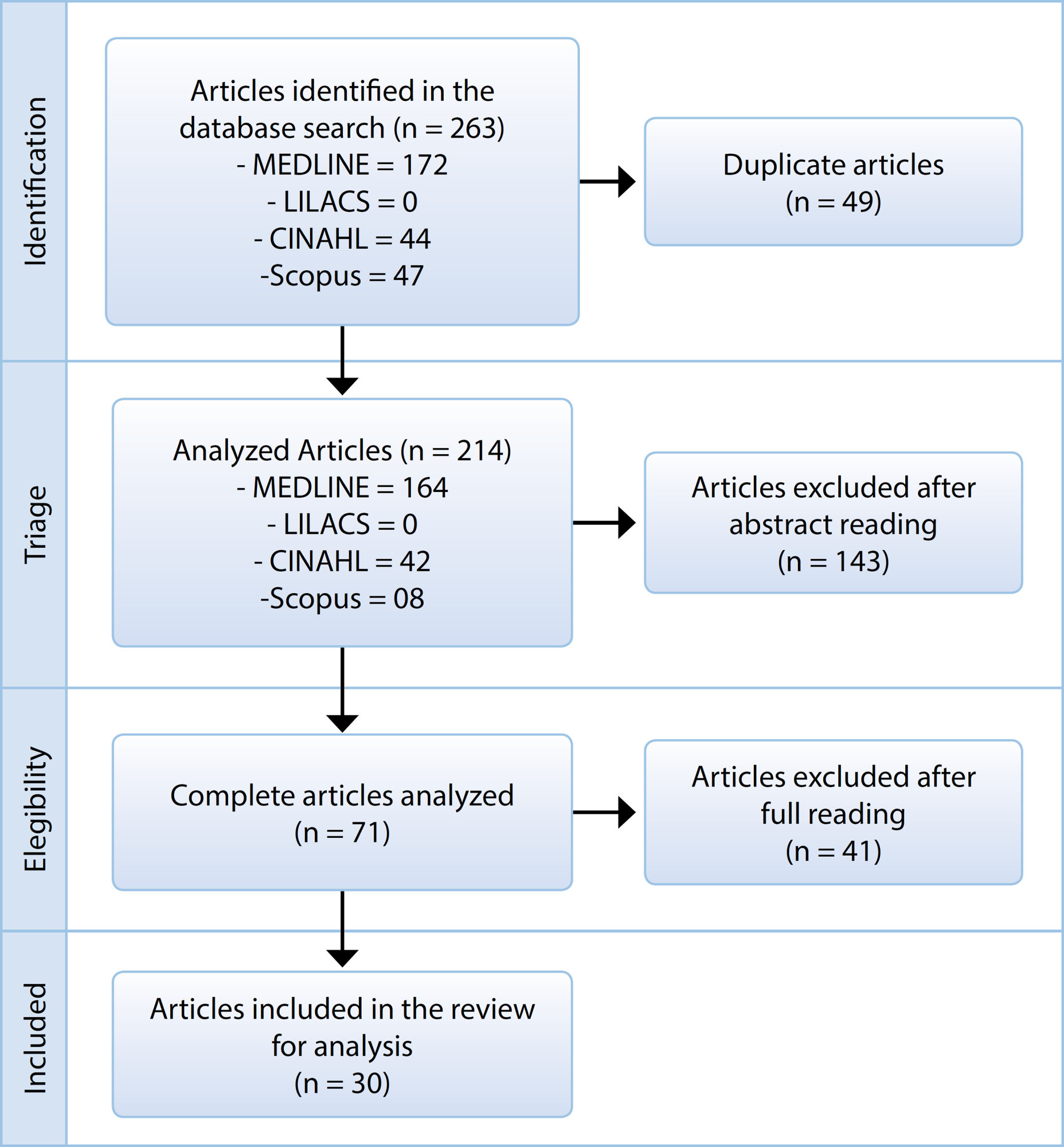
-
EXPERIENCE REPORT06-11-2021
Care management in coping with COVID-19 at a teaching hospital
Revista Brasileira de Enfermagem. 2021;74:e20200970
Abstract
EXPERIENCE REPORTCare management in coping with COVID-19 at a teaching hospital
Revista Brasileira de Enfermagem. 2021;74:e20200970
DOI 10.1590/0034-7167-2020-0970
Views0ABSTRACT
Objective:
to report the experience of implementing care management strategies in coping with the COVID-19 pandemic in a teaching hospital.
Method:
this is an experience report of the managers who work at the largest public hospital in Paraná with functions as Head of the Care Management Division, Head of the Care Lines Management Sector, Head of the Infectiology Unit and support team.
Results:
care management strategies were structured based on the service dynamics; physical structure; human Resources; professional and user safety.
Final considerations:
preparing for a pandemic involves measures that include modifying infrastructure and processes, managing employees and users, infection prevention strategies, and clinical recommendations. These measures are necessary to optimize the quality of care provided to users with COVID-19 and to reduce the risk of viral transmission to other users or health professionals.
Keywords:BetacoronavirusCoronavirus InfectionsHealth AssistanceHealth ManagementHealth Services AdministrationSee more -
ORIGINAL ARTICLE10-26-2020
Suspected COVID-19 flu-like syndrome in men who have sex with men and have been involved in casual sex
Revista Brasileira de Enfermagem. 2020;73:e20200913
Abstract
ORIGINAL ARTICLESuspected COVID-19 flu-like syndrome in men who have sex with men and have been involved in casual sex
Revista Brasileira de Enfermagem. 2020;73:e20200913
DOI 10.1590/0034-7167-2020-0913
Views0See moreABSTRACT
Objective:
To evaluate the presence of flu-like syndrome suggestive of COVID-19 in men who have sex with men (MSM) and engaged in casual sex during a period of social isolation.
Method:
National epidemiological survey, applied in April and May 2020, by adaptation of Respondent Drive Sampling.
Results:
1,337 MSM participated in the survey, of which 514 (38.4%) had fever associated with another sign or symptom of flu-like syndrome. Social, demographic characteristics, sexual practices and activities during the period of social isolation were statistically associated with the presence of flu-like syndrome. There was a statistical difference (p < 0.001) in the average of partners between those who had signs and symptoms of flu-like syndrome (3.5) and those who did not (1.7).
Conclusion:
Evidence of signs and symptoms indicative of flu-like syndrome suggestive of COVID 19 in Brazilian MSM who were involved in casual sex during the period of social isolation.

-
ORIGINAL ARTICLE08-10-2020
Palliative care consultation team: symptom relief in first 48 hours of hospitalization
Revista Brasileira de Enfermagem. 2020;73(6):e20190391
Abstract
ORIGINAL ARTICLEPalliative care consultation team: symptom relief in first 48 hours of hospitalization
Revista Brasileira de Enfermagem. 2020;73(6):e20190391
DOI 10.1590/0034-7167-2019-0391
Views0ABSTRACT
Objective:
To compare the relief of symptoms provided by palliative care consultation team (PCCT) compared to the traditional care team (TC), in patients with advanced cancer in the first 48 hours of hospitalization.
Method:
Allocated to PCCT Group and TC Group, this study assessed 290 patients according to the Edmonton Symptom Assessment System (ESAS) within the first 48 hours of hospitalization. The main outcome was a minimum 2-point reduction in symptom intensity.
Results:
At 48 hours, the PCCT Group had a 2-point reduction in the mean differences (p <0.001) in pain, nausea, dyspnea, and depression; and TC Group, on nausea and sleep impairment (p <0.001). Multiple Logistic Regression found for the PCCT Group a greater chance of pain relief (OR 2.34; CI 1.01-5.43; p = 0.049).
Conclusion:
There was superiority of the PCCT Group for pain relief, dyspnea and depression. There is a need for more studies that broaden the understanding of team modalities.
Keywords:Pain ManagementPalliative CareSymptom AssessmentTerminal Patient CareTreatment EffectivenessSee more -
REVIEW10-05-2020
Self-efficacy of health professionals in hand hygiene practice: is it possible to measure?
Revista Brasileira de Enfermagem. 2020;73:e20190873
Abstract
REVIEWSelf-efficacy of health professionals in hand hygiene practice: is it possible to measure?
Revista Brasileira de Enfermagem. 2020;73:e20190873
DOI 10.1590/0034-7167-2019-0873
Views0See moreABSTRACT
Objective:
To identify in the literature the tools used to measure self-efficacy of health professionals in hand hygiene.
Methods:
Integrative literature review carried out by consulting the databases PubMed, Scopus, Web of Science, Cumulative Index to Nursing and Allied Health Literature, Europe PubMed Central, and Science Direct using the descriptors Self Efficacy, Hand Hygiene, and Health Personnel.
Results:
Six articles, all of which with observational design, were selected. It was possible to infer that four studies used validated instruments to measure self-efficacy of health professionals in the conformity with the recommendations for hand hygiene. The other studies used questionnaires that were not validated.
Final considerations:
Despite the extensive literature on hand hygiene, there is a lack of scientific evidence regarding the use of validated instruments to measure self-efficacy of health professionals in the procedure. The use of properly validated psychometric instruments is useful to guarantee the quality of results in studies.
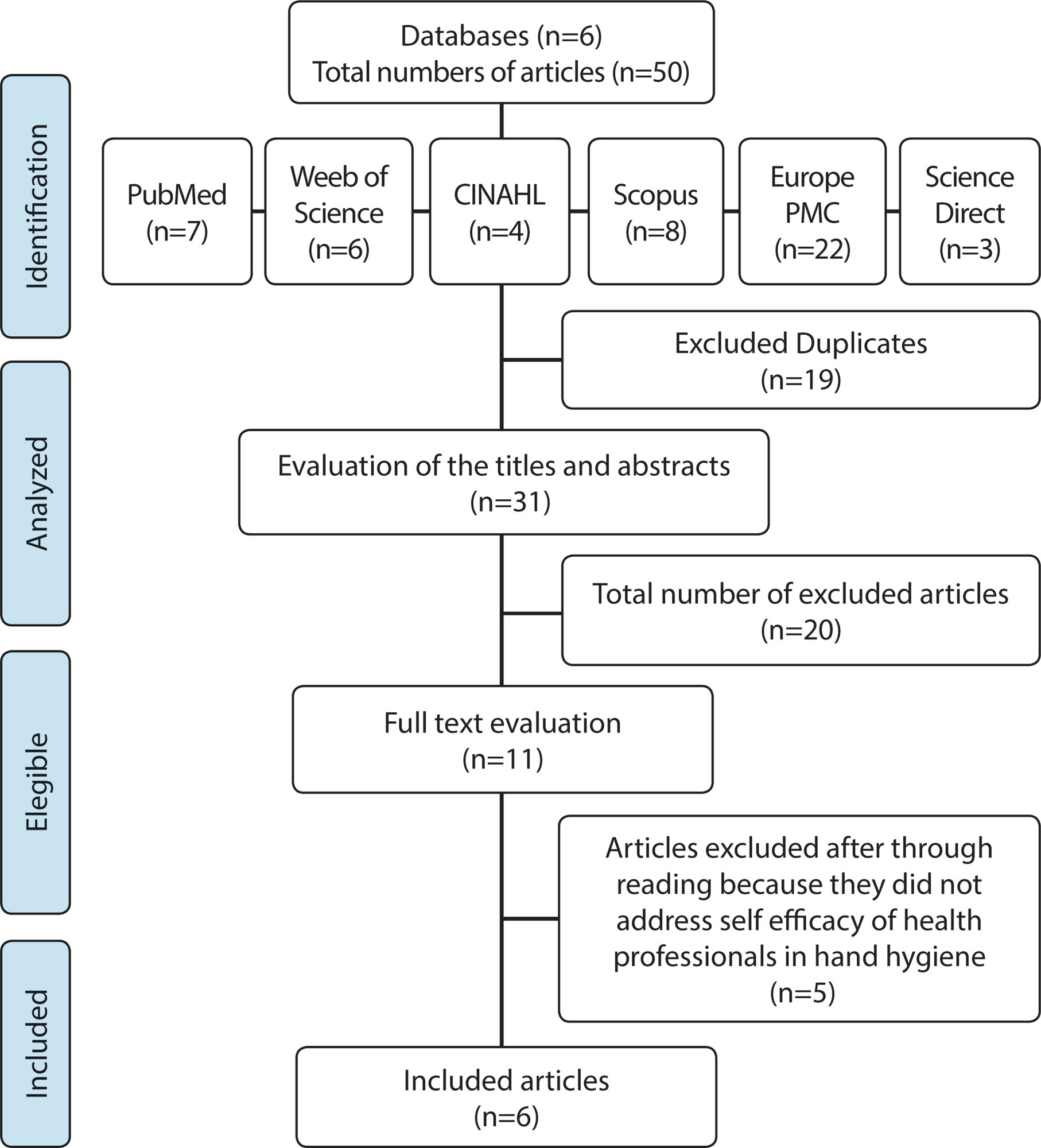
-
REVIEW07-09-2021
Breast cancer screening in Primary Health Care in Brazil: a systematic review
Revista Brasileira de Enfermagem. 2021;74(3):e20200995
Abstract
REVIEWBreast cancer screening in Primary Health Care in Brazil: a systematic review
Revista Brasileira de Enfermagem. 2021;74(3):e20200995
DOI 10.1590/0034-7167-2020-0995
Views1See moreABSTRACT
Objectives:
to analyze care strategies for breast cancer screening in Primary Health Care in Brazil.
Methods:
this is a systematic review following the Cochrane Collaboration recommendations.
Results:
among 355 manuscripts, five were eligible. The patient navigation program by Community Health Agent stood out with the best result, among the strategies: flexibility of goals considering viability; community engagement; team training; active search of the target population by Community Health Agent; request for mammography by physicians; actions integrated to women’s health; monitoring of mammography results, absent users, and population coverage by physician and nurse; and assessment of criteria for requesting screening mammography by means of an information system. The population coverage rate in the program ranged from 23% to 88%.
Conclusions:
Primary Health Care in Brazil presents devices with potential to induce the production of care for breast cancer screening.

-
REFLECTION02-15-2021
The belief in health in the adoption of COVID-19 prevention and control measures
Revista Brasileira de Enfermagem. 2021;74:e20200576
Abstract
REFLECTIONThe belief in health in the adoption of COVID-19 prevention and control measures
Revista Brasileira de Enfermagem. 2021;74:e20200576
DOI 10.1590/0034-7167-2020-0576
Views0See moreABSTRACT
Objective:
Reflect, in the light of the Health Belief Model, on the adoption of behavioral measures in the context of COVID-19.
Methods:
Theoretical-reflective essay, based on the Health Belief Model, to reflect on adherence to preventive behaviors in the pandemic of COVID-19.
Results:
Adherence to preventive behaviors is strongly influenced by socioeconomic, territorial, political and individual factors in the face of critical health situations. In addition, the spread of false news modulates the thinking and execution of behavioral actions in the population.
Final Considerations:
It is necessary to understand the importance of health communication processes and the use of tools aimed at responsible human behavior and engaged in the adoption of a preventive posture.
Search
Search in:
Nuvem de Tags
Aged (144) Atenção Primária à Saúde (239) COVID-19 (104) Cuidados de Enfermagem (269) Educação em Enfermagem (151) Educação em Saúde (139) Enfermagem (930) Estudos de Validação (131) Health Education (144) Idoso (208) Mental Health (149) Nursing (987) Nursing Care (306) Patient Safety (151) Primary Health Care (284) Qualidade de Vida (104) Quality of Life (106) Saúde Mental (145) Segurança do Paciente (150) Validation Studies (108)



